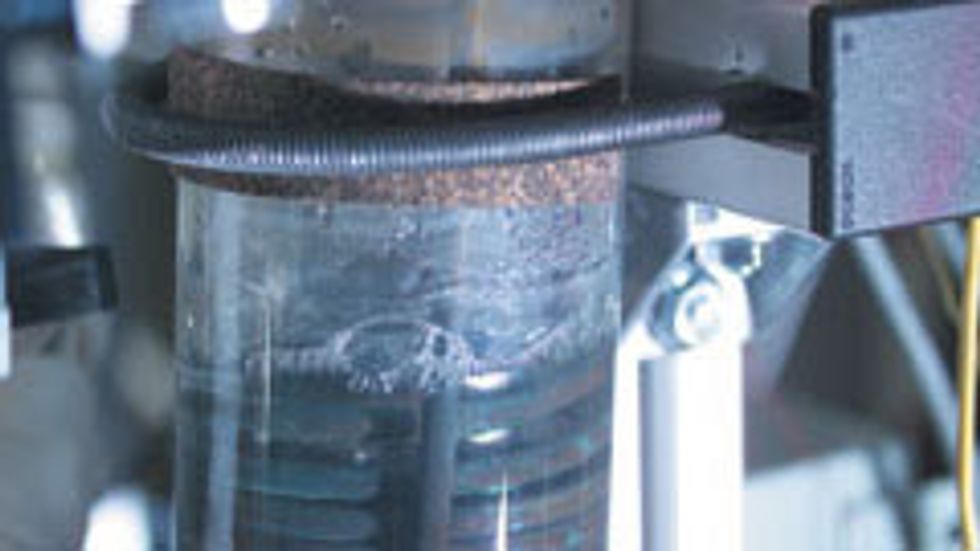Energy systems using hydrogen could free us from dependence on oil and from the threats of smog and greenhouse gases. Yet three problems make hydrogen prohibitively expensive: generating it from a clean source, storing it, and moving it to wherever it's needed.
A solution to the first problem—the clean generation of hydrogen—may be at hand. In November, researchers at the DOE's Idaho National Engineering and Environmental Laboratory (INEEL), in Idaho Falls, found a better way to break water into hydrogen and oxygen. They run fuel cells in reverse: instead of turning hydrogen into electricity, they turn electricity into hydrogen. And by doing so at 850 °C, they get nearly twice the efficiency of the electrolysis of water into hydrogen and oxygen.
"We're taking high-temperature steam and electricity and producing hydrogen," says Stephen Herring, the lead researcher for this project. The solid-oxide electrolysis cells, as they are called, are made by Ceramatec Inc., of Salt Lake City, which develops ceramic energy systems, especially fuel cells.
Fire burn and cauldron bubble: Hydrogen bubbles from an electrically heated electrolytic cell at a U.S. Energy Department laboratory in Idaho. A proposed commercial version would get its input heat and electricity from a nuclear reactor.
The new method could offer advantages over the method by which the United States now gets 95 percent of its hydrogen: the re-formation of natural gas. "The problem with [re-forming] is twofold," says Phil MacDonald, a nuclear engineer at INEEL. "It releases a lot of carbon dioxide into the atmosphere. Second, it would put pressure on the price of natural gas that we burn for our home heating." In addition, producing and delivering hydrogen from natural gas costs about US $4 to $5 per kilogram. Since a kilogram of hydrogen has the energy of a gallon (2.8 kg) of gasoline, this process would cost about three times the present U.S. retail price of gasoline.
Electrolysis of water is currently even more expensive, at about $7 to $9 per kilogram of hydrogen produced. This means that the new method makes sense only if the energy needed for electrolysis comes from a cheap, non-carbon-emitting source. The only likely candidate is a nuclear reactor, which would boil water into steam. Some of the steam, heated to about 850 °C, would be fed to one of the fuel cell's electrodes, facilitating electrolysis; the rest would drive a turbine that would turn a generator, powering the cell. The plan requires a reactor that can run some 550 °C hotter than today's models, and that would mean replacing metal components with ceramics or graphite and cooling with helium gas instead of water.
The DOE's plans for nuclear hydrogen are ambitious. By 2015, the goal is to demonstrate the first reactor having a thermal output of 600 megawatts and producing about 2.5 kg of hydrogen per second, at a cost of $1.50 per kilogram. These reactors "would supply the transportation needs of about a quarter million people [a day]," Herring says.
It doesn't seem likely to happen without a sea change in public opinion. No one in the United States has commissioned a new nuclear plant in 30 years, let alone one based on a new design requiring a large capital outlay. "It's not attractive economically...in an uncertain pricing environment," says Joseph Romm, former acting assistant secretary of energy and author of The Hype about Hydrogen: Fact and Fiction in the Race to Save the Climate (Island Press, Washington, D.C., 2004). Besides, using nuclear energy doesn't ease the hydrogen storage problem. A practical scheme would make hydrogen close to where it will be used, Romm says, and you can't do that with nuclear sources. "You are going to be killed on the capital cost and the transport cost," he says.
To keep the dream of hydrogen alive, the INEEL researchers talk of using it to refine low-grade petroleum and make synthetic fuels. But if the goal is to cut greenhouse gas emissions, why use the hydrogen to refine petroleum? In fact, why make hydrogen at all? If instead we used nuclear energy to replace coal-fired power plants, it would save four times as much in carbon dioxide emissions. And if the goal is to reduce petroleum imports, Romm says, then hydrogen can be made more efficiently from natural gas.
Using nuclear power to make hydrogen is "a long stretch," he says. "It's an idea whose time is not likely ever to come."
